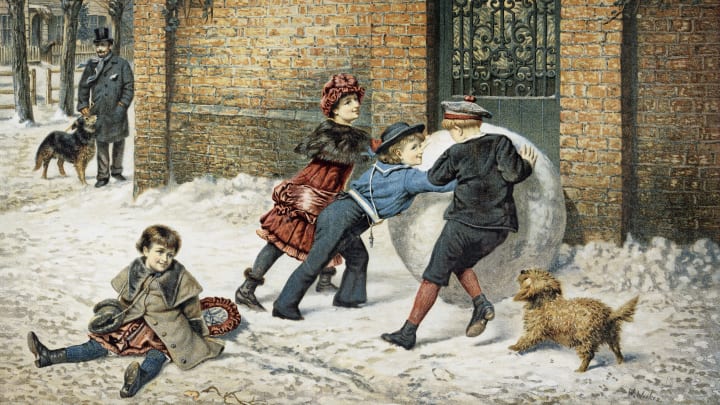7 Fun Cold Weather Activities Beyond Snowmen

When the mercury drops, you might be tempted to stay inside, but what's the fun in that? Snow, ice, and freezing temperatures may be hard on your heating bill, but there are plenty of fun things to do outside. Just make sure to dress warmly, beware of walking on slippery ice, and take breaks to warm up inside.
1. FROZEN BUBBLES
Bubbles are typically a warm weather activity, but they can be just as fun in freezing temperatures. If it's cold enough, you can blow soap bubbles and watch them freeze before they pop! Instructables member pi526 has a recipe for homemade bubble liquid, and tips for getting photographs of those neat creations. Depending on the temperature, you might be able to watch ice crystals form while they freeze. Bubbles that come into contact with a surface will freeze if they don't pop first. They might pop in the process of freezing, which leaves fascinating shapes to study, or they might freeze completely and then break to resemble a broken glass Christmas ornament. Or you might see your bubbles still frozen the next day.
2. BOILING WATER SNOW
The temperature outside has to be pretty cold to make instant snow out of boiling water. If you live where winter temperatures drop way below freezing, you might want to try this. When Yan recorded this video the thermometer read -13°F (-25°C). Bring water to a boil in a pan or coffee cup, and take it outside and throw it in the air. Be sure to throw it away from you, so you don't get burned. When the rapidly-evaporating water vapor hits the cold air, it turns to snow. It has to be hot water, close to its gaseous form, to disperse well. Cooler water will just splash in droplets and then freeze on the ground. See it happen at -40°, as a man in Russia creates a several-stories tall snow cloud.
3. ICE SWORD
Naturally-formed ice has an unpredictable strength. Pykrete is ice formed by freezing water with a content of 14 percent wood pulp. The wood fibers strengthen the ice and make it much harder to shatter. Pykrete also melts at a much slower rate than ice. It was developed by Geoffrey Pyke, who envisioned ships made of pykrete in World War II. Alan Pan used pykrete to mold a huge ice sword—complete with embedded LEDs. Watch him try some experiments to test its strength above. You, too, can be smashing watermelons in the middle of winter.
4. MAPLE SYRUP TAFFY
Maple syrup taffy is candy made from maple syrup cooled to the consistency of taffy on a bed of freshly fallen snow. You can do this outside, or inside if you work quickly. Here's a recipe, although you might want to use popsicle sticks instead of your fingers—especially if you plan to share it.
5. GLOWING IGLOO
While on winter vacation in Edmonton, Alberta, Daniel Gray and Kathleen Starrie of New Zealand made colored bricks of snow, water, and food dye packed into milk cartons and set them outside to freeze. They used around 500 of the bricks to build this Technicolor igloo. You can see pictures of the process and the finished product in this album.
6. BUILD YOUR OWN SLED
Sledding is a great winter activity, but if you have more kids than sleds, you may have to get creative. In freezing weather, you can make solid items out of fabric with a little water and time. The folks at Minnesota Cold formed a sled out of a towel, and it works just fine. Minnesota Cold has a series of freezing weather activities to try at your own risk.
7. SUPERCOOLED WATER
Water is supercooled when it gets below freezing temperature without turning to solid ice. Pure filtered or distilled water can stay liquid below freezing because it lacks the mineral particles that act as "seeds" for crystallization. That's what happened to this guy when he left bottles in his vehicle overnight. But when you bump the bottle good enough, it causes air bubbles to seed the ice crystals, which immediately spread throughout the container. If it's cold enough, you can watch an entire bottle freeze up in seconds! Get a closer look at the crystallization here. You can do this experiment indoors, too.